
Encyclia tampensis or Tampa butterfly orchid is a species of flowering plant in the orchid family, subfamily Epidendroideae. It has been placed in Encyclia sect. Hymenochila.

Epidendrum blepharistes is a species of orchid in the genus Epidendrum native to Bolivia, Colombia, Costa Rica, Ecuador, Peru, and Venezuela.
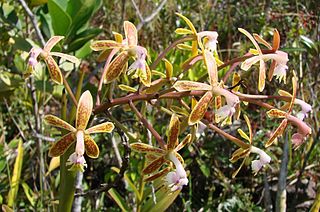
Epidendrum cristatumRuiz & Pav. (1789) is a species of orchid in the genus Epidendrum which is known to grow both terrestrially and epiphytically at altitudes near 1 km in the Neotropics from Mexico and Belize down through Brazil, as well as Trinidad.

Epidendrum ciliare, synonyms including Coilostylis ciliaris is a species of orchid. It is known as the fringed star orchid. It has a wide distribution from Mexico through Central America and the Caribbean to northern and western South America.
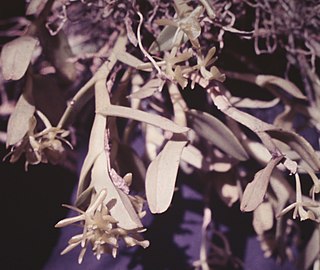
Epidendrum difforme is a species of orchid in the genus Epidendrum. In 1861, Müller classified this species in the subsection Umbellata of the section Planifolia of subgenus EuepidendrumLindl. of the genus Epidendrum.

Epidendrum conopseum, synonym Epidendrum magnoliae, sometimes called the green-fly orchid, is a species of orchid in the genus Epidendrum. It is the most northern-growing epiphytic orchid in North America, being found wild in the southeastern United States from Louisiana to North Carolina, and also in northeastern Mexico.
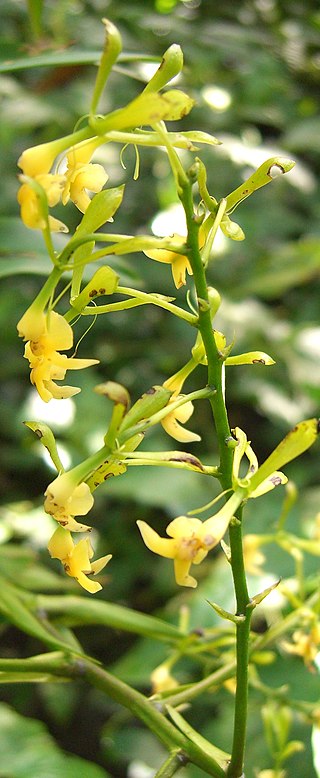
Epidendrum paniculatum is a species of orchid in the genus Epidendrum.
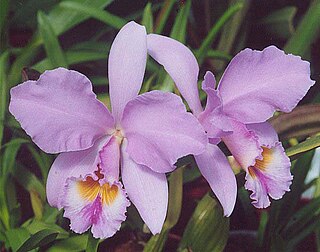
Cattleya gaskelliana is a labiate Cattleya species of orchid. The diploid chromosome number of C. gaskelliana has been determined as 2n = 40.

Cattleya granulosa is a bifoliate Cattleya species of orchid. It is endemic to Brazil; the type specimen was reported to come from Guatemala, but this is likely erroneous. The diploid chromosome number of C. granulosa has been determined as 2n = 40.

Cattleya guttata is a bifoliate Cattleya species of orchid. The diploid chromosome number of C. guttata has been determined as 2n = 40.

Cattleya mossiae, commonly known as the Easter orchid, is a species of labiate Cattleya orchid. The white-flowered form is sometimes known as Cattleya wagneri. The diploid chromosome number of C. mossiae has been determined as 2n = 40. The haploid chromosome number has been determined as n = 20.

Cattleya warscewiczii, a labiate Cattleya, is a species of orchid.

Encyclia patens is a species of orchid native to east and south Brazil. Encyclia flava is a synonym of Encyclia patens var. patens.
Epidendrum latilabre is a species of orchid of the genus Epidendrum which occurs naturally in French Guiana, Peru and Brazil. The diploid chromosome number of E. latilabre has been determined as 2n = 40.

Epidendrum rigidum is an epiphytic reed-stemmed Epidendrum orchid common throughout the Neotropical lowlands, below 600 m (2,000 ft).

Epidendrum subsect. CarinataRchb.f. (1861) is a subsection of the section E. sect. SchistochilaRchb.f. (1861) of the subgenus E. subg. AmphiglottiumLindl. (1841) of the genus Epidendrum of the Orchidaceae. This subsection differs from the subsection E. subsect. Integra in that the margins of the trilobate lip are dentate or lacerate. This subsection differs from the subsection E. subsect. Tuberculata by possessing a keel or carina on the midlobe of the lip. In 1861, Reichenbach listed nine species in this subsection.

Epidendrum calanthum is a terrestrial reed-stemmed Epidendrum orchid from the montane Tropical rainforest of Bolivia, Colombia, Ecuador, Peru, Venezuela, and the West Indies.

Dimerandra, abbreviated Dmd. in the horticultural trade, is a genus of flowering plants from the orchid family, Orchidaceae. The group is found across tropical America: southern Mexico, Central America, the West Indies and northern South America.
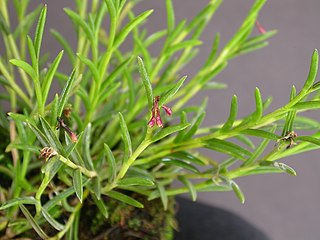
Jacquiniella is a genus of flowering plants from the orchid family, Orchidaceae. It is native to Mexico, Central America, the West Indies, and South America.
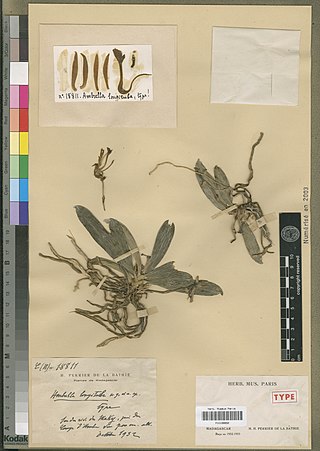
Ambrella is a monotypic genus in the orchid family. The single species, Ambrella longituba is endemic to Madagascar. The type specimen was collected and described by Joseph Marie Henry Alfred Perrier de la Bâthie in 1934.





















